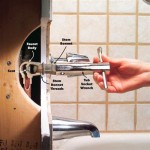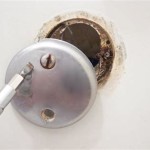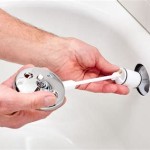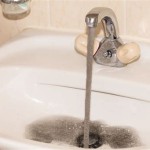What Size Is A Standard Bathtub Drain?
Determining the appropriate size for a bathtub drain is a crucial aspect of plumbing installations and renovations. The drain's dimensions directly influence its ability to efficiently remove water, preventing overflows and potential water damage. While a single "standard" size is often referenced, variations exist based on factors like bathtub type, installation standards, and regional plumbing codes. Understanding the prevailing dimensions and the factors influencing them is essential for plumbers, homeowners, and contractors alike.
This article provides a comprehensive exploration of typical bathtub drain sizes, delving into the specifics and variations encountered in residential plumbing systems. It will cover the most common dimensions, the considerations that influence selection, and the potential issues that can arise from using an incorrectly sized drain.
Standard Drain Opening Diameter: An Overview
The most commonly cited measurement for a standard bathtub drain opening is 1 1/2 inches in diameter. This measurement refers to the inside diameter of the drainpipe that connects to the bathtub's drain flange. This size is prevalent in a wide range of standard bathtubs found in homes across North America and other regions adhering to similar plumbing conventions.
The 1 1/2 inch diameter is considered a balance between water flow capacity and ease of installation. It provides sufficient drainage for typical bathing scenarios without necessitating excessively large and potentially cumbersome plumbing connections. The availability of fittings and fixtures designed for this size further solidifies its status as a standard.
It's important to note that this 1 1/2 inch measurement primarily applies to the drain opening and the connected piping. The actual drain flange, which is the visible metal piece that sits flush with the bathtub surface, may have a larger diameter. This wider flange is designed to cover the drain opening neatly and create a watertight seal.
Variations and Influencing Factors
While the 1 1/2 inch drain opening diameter is dominant, circumstances can necessitate or justify variations. These variations are influenced by several factors, including the specific design of the bathtub, local plumbing codes, and the desired drainage performance. It's crucial to be aware of these factors to ensure appropriate drain selection for a given installation.
Bathtub Type: The style of the bathtub itself can impact the drain size. Whirlpool tubs and other high-volume tubs may benefit from larger drain sizes (e.g., 2 inches) to handle the increased water flow generated by the jets and the rapid emptying required after use. Similarly, some older bathtubs or those manufactured in regions with different plumbing standards may utilize different drain sizes. Careful measurement and referencing the manufacturer’s specifications are crucial in these cases.
Plumbing Codes: Local and regional plumbing codes often dictate minimum drain sizes for various fixtures, including bathtubs. These codes are designed to ensure adequate drainage and prevent sewage backups. Adherence to these codes is mandatory for legal compliance and maintaining the safety and functionality of the plumbing system. Always consult local codes before commencing any plumbing work.
Drainage Requirements: Individual preferences and anticipated usage patterns can also influence drain size selection. For example, a household with a high volume of bathing activity may opt for a slightly larger drain size to enhance drainage speed and minimize the risk of slow draining or standing water. However, this decision must be weighed against the potential complications of adapting larger drainpipes to existing plumbing infrastructure.
Waste and Overflow (W&O) Configuration: The type of waste and overflow system used in the bathtub also plays a role, though it doesn't directly change the drain opening size. The W&O system is the assembly of pipes and fittings that connect the drain to the overflow outlet, preventing the tub from overflowing. Different W&O configurations may require specific drain tailpieces and adapters to ensure a proper connection. The tailpiece is the section of pipe directly attached to the drain flange under the tub. It connects the flange to the rest of the drain system.
Potential Issues with Incorrect Drain Sizing
Using an incorrectly sized drain can lead to a range of problems, from minor inconveniences to significant plumbing failures. These issues can affect both the functionality and longevity of the bathtub and the surrounding plumbing system. Therefore, careful attention to drain sizing is essential during installation and replacement.
Slow Draining: An undersized drain will restrict the flow of water, leading to slow draining. This can be frustrating for users, as it requires waiting for the tub to empty after bathing. Prolonged exposure to standing water can also promote the growth of mold and mildew, creating unsanitary conditions.
Overflows: In extreme cases, an undersized drain may not be able to keep up with the inflow of water, resulting in overflows. Overflows can cause water damage to floors, walls, and ceilings, leading to costly repairs. This is particularly problematic in households with young children or individuals who are prone to accidentally overfilling the tub.
Plumbing Blockages: An inappropriately sized drain can be more susceptible to blockages. Hair, soap scum, and other debris can accumulate more easily in a drain that is too narrow, restricting water flow and eventually causing a complete blockage. Regularly maintaining the drain and using a drain screen can help prevent these issues, but proper sizing is the first line of defense.
Leaks at Connections: Adapting an incorrect drain size to existing plumbing can lead to leaks at the connection points. For example, forcing a smaller drainpipe into a larger opening may create a weak seal that is prone to leaking over time. These leaks can be difficult to detect and can cause extensive water damage before they are noticed.
Code Violations: Using an inappropriately sized drain can violate local plumbing codes, potentially resulting in fines or the requirement to redo the installation. Code compliance is essential for ensuring the safety and functionality of the plumbing system and for maintaining the value of the property.
To mitigate these potential issues, it is always best practice to consult with a qualified plumber or refer to the bathtub manufacturer's specifications when selecting a drain. Professional guidance can help ensure that the drain is properly sized for the specific application and that the installation meets all applicable codes and standards.
In conclusion, while 1 1/2 inches is often considered the "standard" bathtub drain size, variations exist based on factors such as bathtub type, local plumbing codes, and drainage requirements. Selecting the correct drain size is critical for ensuring proper drainage, preventing overflows, and avoiding potentially costly plumbing problems.

Pin Page

How To Size A Tub Drain

Pin Page

0184000 020 American Standard Colony Integral Apron Tub Left Hand White Steel Build Ca

Exposed Drains For Vintage Clawfoot Bathtubs

How To Identify Your Tub Drain Style A Comprehensive Guide Hofen

Everbilt Twist And Close 1 2 In White Poly Pipe Bath Waste Overflow Drain Chrome Sh 7100 P 01 02 The Home Depot

Universal Tubs Hd Series 60 In Left Drain Step Walk Soaking Bath Tub With Low Entry Threshold White Hdsi3060lws The Home Depot

How To Size A Tub Drain

What Is The Standard Tub Drain Size
Related Posts








